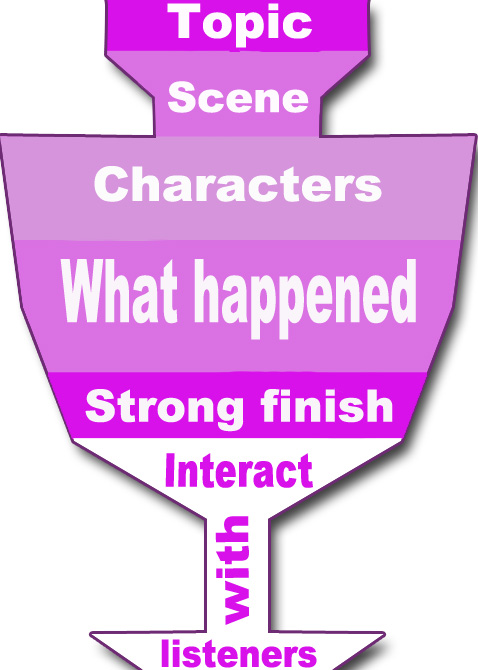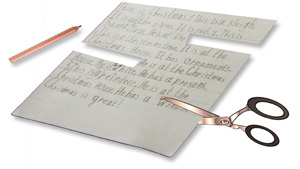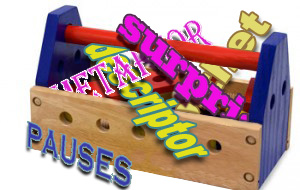
How to Develop Storytelling Skills in English
- By Val
- Posted Aug 11, 2018
Although in today's fast changing world no one has the right to physically kill a boring speaker, why should we allow ourselves to verbally torture our listeners? Learn these storytelling techniques and start winning one heart after another and making your life and the lives of others brighter.
Start practicing storytelling in writing, and then retelling your texts. Remember that the best improvisation rests on a thoroughly learned text. None of your favorite stand-up comedians was born with their stories on the tongue. What you see on stage is the result of years and years of practice. Start practicing now and soon you will feel a way more confident, your stories will be more appreciated and your overall standing will improve.
On this page you will find five crucially important blocks:
1. A metaphoric storytelling toolkit
2. Step by step storytelling instructions
3. Five common mistakes to avoid in storytelling
4. A list of stylistic devices to adorn your stories
5. Three take-aways.
Here we go:
1. THE ULTIMATE STORYTELLING TOOLKIT
| Tool | Function | Examples |
Magnifying glass |
Use it to focus on the main idea of what you want to say.
Instead of giving your listener a stream of consciousness, take trouble to identify the REASON, why you want to tell the story and PRONOUNCE it. Is there something that made you sad or happy? Was there something funny or an unusual solution to a problem? Give it as a reason for the people to listen to you. |
Start by saying:
Let me tell you something interesting /a funny story… Did you know that archeologists discovered an underground city? Did you watch the World Cup yesterday? It was an unprecedented walkover! Did you know what happened at the party? |
Template |
Using templates allows us to avoid mess. When you are cooking for the first time, you follow the advice in the cookery book, don't you? If you are making a dress for the first time, you use a template and instructions from a dress-making book, if you need to fix your car, you find a know-how video and follow the instructions there. And if you are driving in a new country, you use a road map. Why not to do the same in story-telling? Just remember this basic storytelling template and follow it. You can use it in any language, not only English, because it is universal.Once you have learned the basics, you can improvise to create something new. But if you do not know the rules of coding, no one will appreciate your messy story. This is why you need a template. TIP: You can exaggerate or invent something to make the story more impressive, as it was done in this story on the right. Remember, you are telling a story to impress and entertain people, and NOT to give them your brain dump, NOT to sound off, NOT to enlighten your listeners on business or science, where everything should be exact and true. |
Topic: I'd like to tell you about my first trip to the seaside. Scene (time and place) I went there when I was three years old. I do not remember the details of the journey, only remember that it was too hot. We arrived late in the evening, but my parents didn't want to wait until morning to meet the sea. Character I was a tiny little boy, much shorter than my friends, about 35 inches tall. I had never been to a lake or to a river. The largest amount of water I had seen was in the bath-tub. My parents had told me that I was going to the sea, but I imagined it to be like in the pictures: a few blue wavy lines, a boat with a flag and the yellow sun. What happened It was getting dark,when we eventually reached the beach. I was not able to see the water, and I thought that there was nothing ahead. I was really scared as we were approaching the visible edge of the beach, because I thought that we all will fall down. When I saw the water, I was really terrified. The sea was rough on that day and the waves were rising higher than me. And the sound of the waves, and the sound of the birds, and sound of the cicadas - it was too much for a tired three-year old boy: I fainted. Strong finish When I came round, I saw the pale face of my mother and her eyes full of tears. I thought that she was as much terrified by the sea and I was. And, being a super-hero at heart , I said, "Don't be afraid, Mummy. I will take you away from that sea." Interact with the listener And what are your first impressions of the sea? |
|
Devices and
|
Your materials and devices in storytelling are: mental images, as well as the words and stylistic constructions that you need to create them. Use descriptors to let the listeners visualize the scene and the characters, use epithets to add emotions, and use stylistic devices to make your talk more dynamic and emphatic (follow the instructions below). |
Compare the two passages. Which one, (a) or (b) is more captivating? Why? Highlight the words that make it more expressive. These are stylistic devices. You can find the names of the stylistic devices in the table below on this page. a) In the winter, green citrus tree, that were growing on the slopes of the mountain, bore big oranges and lemons. b) In the winter, heavy yellow and orange citrus dot the emerald green hillside running down to the sea. By Ariel Ramchandani |
Scissors |
Scissors are a very important tool, which will help you avoid wordiness. Use them to trim your story. A rule of thumb: Make your texts either short OR beautiful and enjoyable. Remember: Brevity is the sister of talent. If there is a word you can delete without ruining the story – cut it out. |
You will find examples below. |
2. STEP BY STEP STORYTELLING GUIDELINES

|
IMPORTANT: If you do not have developed storytelling skills, your text might come out as a mess of words and phrases. This might be very frustrating and your self-esteem can drop the lowest of the low. Comparing your story with the published texts that you read, you might start thinking that writing is not your cup of tea. This would be WRONG! Remember that published texts are the finished product, and readers never know the starting point. All successful authors work on their texts and re-write them several times before publishing. Do not panic - it is perfectly normal to come up with a mess at the beginning. Look at what you have written, organize it and improve. |
Step 1. Decide why are you going to tell this particular story? Is it amusing? Is it informative? Is it an update on something people are interested in?
This will help you decide how to present it.
Step 2. Write your message in just one sentence of five-seven words. Paste it in front of your eyes. Look at it each time you start a new paragraph. This will help you focus and avoid annoying deviations.
Step 3. Write the "skeleton" of your story. Follow the template and write one sentence for each part.
Step 4. Put the "flesh" on the "bones" of your story. This is the most challenging part. Please, find Five Common Storytelling Mistakes to Avoid and a list of Popular Stylistic Devices below.
Step 5. Read, edit, proofread (correct the mistakes).
Step 6. Read it again. Still not happy?
Repeat Step 5. All great writers spent more time on editing than on writing. It's OK, if you leave your story for a while until you forget what you have written there and then read it again, as if it were not yours. Edit and proofread. When finished, read it again as non-stop.
Are you happy? Publish it on our Community Talk! You can read some publications here (adults) and here (school students)
If you are new to our site and need advice, use Help here.
Step 7. Practice telling your story standing in front of the mirror. This will help you monitor your body language and keep eye contact.
You can also tell your story to your cat or dog - they are great listeners and will never interrupt or criticize you :-).
And the final step in practicing should be video-recording yourself. Not happy with what you see? Keep working until you are proud of yourself. Remember: practice makes perfect.
P.S. Remember that storytelling is all about stirring listeners emotions. You can make people feel happy, sad, surprised, flattered, scared, proud, sympathetic if you use the appropriate content and language. Keep reading to find out how to do that.
3. FIVE COMMON STORYTELLING MISTAKES TO AVOID
| Imperfections | More Effective Way | |
| 1. |
Naming events, opinions and feelings without giving descriptions. This prevents the listener from imagining what you are telling. without having this information the listener cannot make their judgement and is forced to accept your evaluation. This is a kind of disrespect and manipulation.
E.g.
Then we had dinner and went to bed. Is that really interesting? Everyone has dinner. Everyone goes to bed. Why should you be telling that?
|
Use descriptors. Report some of the sensual experience and your emotional reaction: The blossoming gardens (visual descriptor) of this tiny town (size) immediately charmed me, made me stop and forget about the anxiety of my travelling (explanation of why you felt happy - the listener can remember the same situation from their own experiences, understand how you felt and share this feeling ). Finally, we managed to get some food. After two hours of walking in search of a good place to sit and relax we got the reward (you describe the change of your feelings: tired and desperate vs happy, which explains why you want to tell people about the dinner). The fish was right from the oven (the feeling of temperature) and smelled so good (the senses of taste and smell) that we could not wait (your reaction to the smell) for the wine that the owned had promised to bring from a special winery (an idea of the service). Having all this information, the listeners can relate to your story, imagine themselves sitting in that cozy place and have feeling too. |
| 2. |
Wrong order of presenting information: starting with details and failing to set the context: What I remember from that trip is a beautiful picture. It was hanging on the wall near the door. There were a lot of flowers too, and I also remember the beautiful furniture. It looked like they were preparing for a holiday. The picture featured a young lady in a white dress.It is impossible to picture the place, which could have explained why the picture impressed the speaker so much. |
Present the information in the same order as you were receiving it. First, give the overview, then give the details and also mention your reaction. What I remember from that trip is a bizarre portrait of a young girl. (This is the topic. The epithet "bizarre" is used to intrigue the listeners) On the last day we were invited by the local NGO to visit their office. They rented three rooms in the old library, which occupied an old Gothic style building near the school. (Setting the scene) When we entered the building, we found ourselves in the dark corridor dimly illuminated by the light coming from through narrow windows near the ceiling. This is why I didn't notice the picture at once. (The use of descriptors allows us to feel the atmosphere in that place) I was able to see it only on our way back, from a distance, and this is why it struck me. It would not have produced such effect If I had seen it in the daylight or standing close by, but in the dim light of that corridor the white dress of the girl reflected the light coming from the windows and created the illusion of streaming in the wind. The hair and the eyes of the girl also caught my attention – they seemed real. I wanted to have a better look, but to my great surprise when I came closer I could see nothing but a chaos of strokes of paint. I still cannot understand how the artist had managed to create that effect of a living being standing in the wind. (This description explains why the teller find the picture ""bizarre") |
| 3. |
Unclear structure. The speaker jumps from one object/character to another, does not follow the chronology of the events, mixes up the narration and comments. In came a woman. She was wearing a light jacket in spite of the cold weather. Oh, I forgot to say that the girl had a father but her mother died, so this was the woman whom her father was having an affair with at that time. |
Group your sentences by the topic.First, set the background and introduce the characters, then present the developments.
The girl's mother died a few years before. In spite of the fact that it was her father who had custody of her, the girl was not getting enough care and attention. (the girl's circumstances) His father was having an affair with a loose woman, which he which he wanted to keep secret. The woman, quite the contrary, wanted to get married, and the reluctance of the man to introduce her to his family annoyed her. (the father's circumstances) So, on that day the woman decided to come to their place to introduce herself and assert her rights. Or, if you wish to intrigue the listeners, you can replace the last sentence in the previous example with this passage: One day the girl was sitting home all alone waiting for her father to come. She heard the door open and ran to meet her father. But it was not the father. In came a woman. She was wearing a light jacket in spite of the cold weather. In this case the listeners, who have received the background information, can build anticipation. You gave them the clue to make the right guess. And who doesn't like the feeling of being smart? |
| 4. |
Giving "dead ends", i.e. excessive details that are not developed later and lead to nothing. Adding more descriptors and details here makes the text bulky. They are not relevant at all and only make the text difficult to read. Alice, who hated playing the piano in the afternoon, was beginning to get very tired of sitting by her elder sister called Jodi on the steep bank of the river in their neighborhood, and of having nothing to do: once or twice she had peeped into the book her sister was reading, but it had no pictures or conversations in it... |
Remove everything that either a) does not give relevant information, or b) does not create an image, or c) does not makes your text expressive, original and memorable. You have scissors in your toolkit - use them! Sometimes you should be ruthless and cut out a whole paragraph or page, if it deviated from the topic. Alice was beginning to get very tired of sitting by her sister on the bank, and of having nothing to do: once or twice she had peeped into the book her sister was reading, but it had no pictures or conversations in it… By Lewis Carroll |
| 5. |
Using plain, straightforward language that lacks intrigue, suspension, unexpected turns, and other stylistic devices. Slowly the sun set and the clouds lost the reddish color. The birds stopped singing too. |
Study and use stylistic devices (download the file here). If you still cannot use them when writing - never mind: you can add them in the process of editing the first draft. Look how the text is made more expressive by means of stylistic devices. You can find personification and you can related to the story by experiencing feeling that you had when grieving over someone's death. Slowly the golden memory of the dead sun fades from the hearts of the cold, sad clouds. Silent, like sorrowing children, the birds have ceased their song. By Jerome K. Jerome |
4. THE MOST POPULAR STYLISTIC DEVICES Download printable version here
|
Device |
Explanation |
Examples |
|
Allusion [ə'lu:žən] |
Indirect reference to a person, event or piece of literature. If the audience is familiar with the event or person, they will also know background and context. Thus, just a few words are enough to create a certain picture (or scene) in the readers’ minds. |
The software included a Trojan Horse. Allusion on the Trojan horse from Greek mythology.
Plan ahead. It was not raining when Noah built the Ark. (Richard Cushing) |
|
Epithet |
A word that creates an image and reveals the emotionally coloured individual attitude of the author towards the object spoken of |
This sick practice kept a gruesome cloud hovering over the population. (Robert W. Barker) |
|
Hyperbole |
Deliberate exaggeration |
I was so hungry, I could eat an elephant. |
|
Gradation (climax) |
A series of similar words or expressions that gradually or, on the other hand, decrease (climax and anticlimax, respectively) the sense or emotional significance. |
… little by little, bit by bit, and day by day, and year by year... (Ch. Dickens) |
|
Litotes ['laitouti:z] |
A form of understatement, which uses the denied opposite of a word to weaken or soften a message. |
That's not bad. (instead of: That's good/great.) Boats aren't easy to find in the dark. (instead of: Boats are hard/difficult to find in the dark.) You're never too cool to learn something new. |
|
Metaphor |
Figurative expression based on comparing two different things |
Through much of the last century, America's faith in freedom and democracy was a rock in a raging sea. |
|
MetOnymy |
Figurative expression, closely associated with the subject in terms of place, time or background. |
The White House declared … (White House = US government / President) (empty pockets = poverty; empty heads = ignorance / dullness / density; empty hearts = unkindness / coldness) |
|
Oxymoron [,oksi'mo:ron] |
Juxtaposition of contradicting terms |
O brawling [bro:liŋ] love! O loving hate! O anything of nothing first create! O heavy lightness, serious vanity! Misshapen chaos of well-seeming forms! |
|
Paradox |
An apparent contradiction that is nevertheless somehow true |
If you try to fail, and succeed, which have you done? (George Carlin) |
|
Personification |
Animals, inanimate objects or abstractions are represented as having human characteristics (behaviour, feelings, character etc.). |
My blood speaks in your veins. And when she weeps, weeps every little flower. |
|
Points of View |
First-person narrator Third-person personal narrator (character) |
Once I was sitting at the railway station…. He didn't know that his company had already fired him. "This is why she didn't reply," thought Mark. |
|
Simile ['simili] |
Direct comparison "A is like B", or "A was as big as B" |
The rabbit-hole went straight on like a tunnel. |
|
Synecdoche [sə'nekdəki] |
The figurative expression, which is a physical part of the subject |
The last morning we required all hands on deck … (hands = people) |
|
Understatement |
Weaken or soften a statement |
I think we have slightly different opinions on this topic. (instead of: I don't agree with you at all.) |
Download printable version here
Learn more about stylistic devices here, here, and here.
*********************************************************************************************************************************
Congratulations, if you have reached the end of this file. By this moment you might feel overwhelmed by the abundance of the information. If you are, here are only three take-aways:
5. THREE TAKE-AWAYS
1. Soft skills like storytelling are important.
2. Start from simple things and keep practicing using these materials for reference.
3. Storytelling is a social activity. Practice telling your stories to your friend. Share your texts in the Community Talk and then in social networks. This way your post will have a URL and will never get lost.
Write in the comments what you think about this tutorial, share your storytelling hacks and experience of telling stories.



















